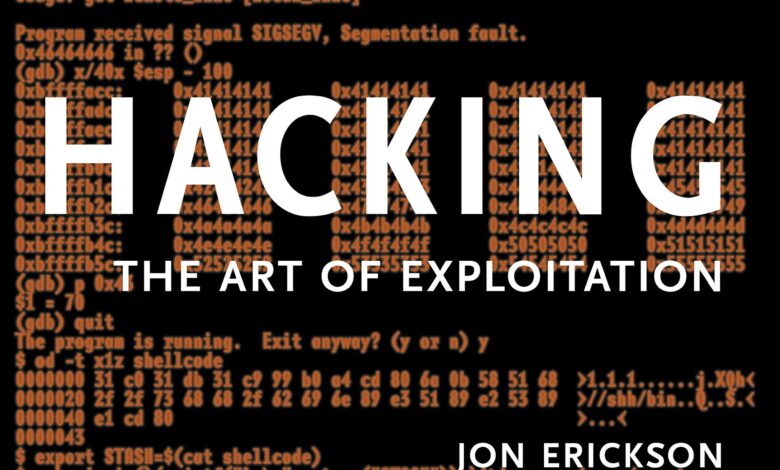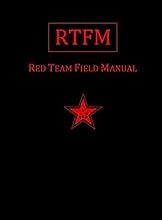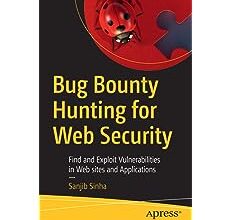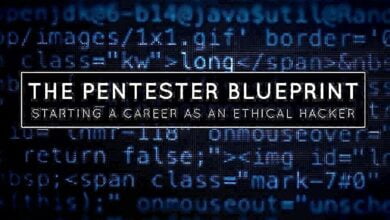
Hey, BugBusters! Are you ready to improve your hacking skills? Let’s dive into The Art of Exploitation, 2nd Edition” by Jon Erickson. This book is an absolute game-changer for anyone looking to master hacking and penetration testing.
Erickson combines deep theoretical knowledge with practical, hands-on tests, covering everything from programming and network communications to memory manipulation. Whether you’re a millennial just starting in cybersecurity or a seasoned pro looking to sharpen your skills, this book covers you.
With its unique approach, The Art of Exploitation teaches you how to think like a hacker, showing you how systems can be penetrated and, more importantly, how to secure them. So, if you’re ready to get hands-on and understand the intricacies of hacking, this is the book for you. Let’s explore why this guide is an essential resource for everyone in the cybersecurity field!
About the Author
Provide a brief background on Jon Erickson, emphasizing his expertise in hacking and cybersecurity and his contributions to the field.
Jon Erickson is a highly respected cybersecurity figure known for his deep expertise in hacking and penetration testing. With a solid background in computer science and years of hands-on experience, Erickson has made significant contributions to the field. He has worked in various roles, from ethical hacker to cybersecurity consultant, helping organizations identify and mitigate system vulnerabilities.
Erickson’s passion for hacking and security is evident in his writing and teaching. He has a knack for breaking down complex concepts into understandable and engaging content, making him a sought-after speaker and educator in the cybersecurity community. His book, The Art of Exploitation, is celebrated for its practical approach to hacking. It combines theory with hands-on exercises to provide readers with a comprehensive understanding of thinking and acting like a hacker. Erickson continues to inspire and educate the next generation of cybersecurity professionals through his work.
Overview of the Book
The Art of Exploitation, 2nd Edition by Jon Erickson masterfully blends theoretical concepts with practical, hands-on tests to offer readers a comprehensive understanding of hacking and penetration testing. This book stands out by explaining the technical details of hacking and immersing readers in the actual process of exploiting vulnerabilities.
Programming: Erickson starts with the basics of programming, offering a solid foundation for understanding how software operates. He delves into the C programming language, which is critical for many hacking techniques, and explains how to write and manipulate code to uncover vulnerabilities. This section is essential for anyone looking to understand the mechanics behind exploits.
Network Communications: The book then moves into network communications, covering protocols, packet analysis, and network security. Erickson teaches readers how to intercept and analyze network traffic, understand the intricacies of TCP/IP, and exploit network vulnerabilities. This section is packed with practical exercises that demonstrate how network-based attacks are executed and defended against.
Memory Manipulation: One of the more advanced topics Erickson tackles is memory manipulation. He explains how to exploit buffer overflows, format string vulnerabilities, and other memory-related weaknesses. By guiding readers through the process of identifying and exploiting these vulnerabilities, Erickson provides invaluable insights into the inner workings of computer memory and how it can be manipulated for both malicious and defensive purposes.
Comprehensive Coverage: The guide is meticulously structured to ensure readers gain a deep and well-rounded understanding of hacking techniques. Each chapter builds on the previous one, creating a cohesive learning experience. Erickson’s approach ensures that readers learn the theoretical aspects of hacking and gain practical skills through hands-on exercises and real-world examples.
The Art of Exploitation offers a thorough education in hacking techniques by focusing on programming, network communications, and memory manipulation. The blend of theory and practice ensures that readers can apply what they learn to real-world scenarios, making it an invaluable resource for anyone serious about mastering hacking and penetration testing.
Overview of the Book
The Art of Exploitation, 2nd Edition by Jon Erickson, is a masterclass in combining theoretical concepts with practical, hands-on tests to provide a holistic understanding of hacking and penetration testing. The book’s unique approach ensures that readers not only grasp the underlying principles of hacking but also get to apply these concepts in real-world scenarios.
Programming: Erickson begins with programming, mainly focusing on the C language, fundamental to many hacking techniques. He explains how to write, manipulate, and understand code to uncover vulnerabilities. This foundational knowledge is crucial for anyone exploring the mechanics behind software exploitation.
Network Communications: The book then delves into network communications, covering the intricacies of protocols, packet analysis, and network security. Readers learn to intercept and analyze network traffic, understand TCP/IP intricacies, and exploit network vulnerabilities. Practical exercises in this section demonstrate how to execute and defend against network-based attacks, making the content highly engaging and applicable.
Memory Manipulation: One of the book’s most advanced and critical sections is memory manipulation. Erickson explains how to exploit buffer overflows, format string vulnerabilities, and other memory-related weaknesses. This section provides invaluable insights into the inner workings of computer memory and teaches readers how to manipulate it for offensive and defensive purposes.
Comprehensive Coverage: The guide is meticulously structured, with each chapter building on the previous one to create a cohesive learning experience. Erickson’s approach ensures that readers learn the theoretical aspects of hacking and gain practical skills through hands-on exercises and real-world examples. This blend of theory and practice sets The Art of Exploitation apart, making it an essential resource for mastering hacking techniques.
The Art of Exploitation offers thorough and engaging coverage of hacking techniques by focusing on programming, network communications, and memory manipulation. Integrating theoretical concepts with practical applications ensures that readers can effectively apply their knowledge in real-world scenarios, making this book an invaluable tool for anyone serious about hacking and penetration testing.
Key Highlights
Programming Exploits: One of the standout sections in “The Art of Exploitation” is its deep dive into programming exploits. Erickson walks readers through the intricacies of the C programming language, providing a foundation for understanding how software vulnerabilities can be exploited. This chapter includes practical examples and exercises demonstrating how to write, manipulate, and exploit code. These hands-on activities make complex programming concepts more tangible and accessible.
Network Hacking: The chapters on network hacking are equally compelling. Erickson covers the fundamentals of network protocols, packet analysis, and network security. He teaches readers how to intercept and analyze network traffic, understand the nuances of TCP/IP, and identify network vulnerabilities. Real-world examples, such as capturing and deciphering network packets, make the theoretical aspects of network hacking come alive. This section is engaging as it combines technical knowledge with practical skills, enabling readers to perform network-based attacks and defenses.
Memory Manipulation: Memory manipulation is one of the most advanced topics covered in the book. Erickson explains how to exploit buffer overflows, format string vulnerabilities, and other memory-related weaknesses. This chapter comprises practical exercises that guide readers through identifying and exploiting these vulnerabilities. By providing detailed step-by-step instructions, Erickson makes the complex world of memory manipulation accessible to a broader audience.
Practical Applications and Real-World Examples: What sets “The Art of Exploitation” apart is its emphasis on practical applications and real-world examples. Throughout the book, Erickson includes case studies and scenarios illustrating how hacking techniques are applied in real-life situations. For instance, he demonstrates how to exploit a vulnerability in a typical software application and then walks readers through defending against such an attack. These examples reinforce the theoretical concepts and show how they can be used to solve real-world problems.
Accessible and Engaging Content: Erickson’s writing style is accessible and engaging, making complex hacking techniques understandable and exciting. He uses clear explanations, practical examples, and hands-on exercises to ensure that readers can grasp and apply the material. This approach makes the book suitable for many readers, from beginners to experienced professionals.
Delving into these key chapters and sections and highlighting the practical applications and real-world examples, The Art of Exploitation provides a comprehensive and engaging learning experience. These features reinforce learning and ensure that readers are well-equipped to apply hacking techniques in their professional work, making the field of cybersecurity both accessible and exciting.
Why It’s Recommended for Cybersecurity Enthusiasts
Discuss the book’s utility for novices and experienced cybersecurity professionals. Explain how it offers a foundational understanding of hacking while providing practical strategies for penetration testing. Emphasize the hands-on knowledge and practical tools it offers.
The Art of Exploitation, 2nd Edition by Jon Erickson is highly recommended for cybersecurity enthusiasts of all levels, and here’s why:
Utility for Novices: This book provides an excellent starting point for those new to hacking and cybersecurity. Erickson breaks down complex concepts into easily digestible sections, making it accessible for beginners. The detailed explanations of programming, network communications, and memory manipulation offer a solid foundation for hacking. Additionally, the hands-on exercises and practical examples help novices understand and apply the theoretical knowledge in real-world scenarios.
Value for Experienced Professionals: Experienced cybersecurity professionals will also find immense value in this guide. The book delves deep into advanced hacking techniques and provides updated strategies for penetration testing. The practical tools and methodologies offered by Erickson enable seasoned practitioners to refine their skills and stay current with the latest developments in cybersecurity. The real-world examples and case studies included in the book allow experienced professionals to see how advanced hacking techniques are applied, enhancing their ability to protect and defend systems.
Foundational Understanding and Practical Strategies: The Art of Exploitation is meticulously structured to help readers understand hacking techniques comprehensively. Each chapter builds on the previous one, ensuring readers develop a solid hacking and penetration testing foundation. Erickson provides practical strategies for identifying and exploiting vulnerabilities, making the material highly relevant and applicable. This combination of foundational knowledge and valuable insights significantly enhances the readers’ ability to conduct practical penetration tests.
Hands-on Knowledge and Practical Tools: One of the book’s standout features is its emphasis on hands-on learning. Erickson includes numerous practical exercises and real-world examples that allow readers to apply theoretical knowledge in a practical context. These exercises help readers develop the skills to perform penetration tests and effectively identify vulnerabilities. The book also offers useful tools and best practices for exploiting and securing systems, providing readers with a comprehensive toolkit for enhancing their cybersecurity capabilities.
In summary, The Art of Exploitation, 2nd Edition, is an invaluable resource for cybersecurity enthusiasts at all levels. It offers a solid foundation for novices, advanced insights for experienced practitioners, and practical tools for dealing with real-world cybersecurity challenges. By providing comprehensive coverage of hacking techniques and practical strategies for penetration testing, this guide ensures that readers are well-equipped to enhance their cybersecurity skills and apply hacking techniques effectively in their professional work.
Engagement and Learning Path
As you dive into The Art of Exploitation, 2nd Edition by Jon Erickson, seeing this book as a cornerstone of your continuous education in hacking and cybersecurity is crucial. Here are some ways to maximize your learning experience:
Engage with Community Forums: Join online forums and discussion groups dedicated to hacking and cybersecurity. Platforms like BugBustersUnited, Reddit, Stack Exchange, and specialized cybersecurity forums are excellent places to discuss concepts from the book, ask questions, and share experiences. Engaging with these communities can offer diverse perspectives, deepen your understanding, and help you apply the techniques more effectively.
Participate in Relevant Workshops: Look for workshops, webinars, and training sessions on hacking and penetration testing. These events often feature hands-on labs and real-world scenarios that complement the material covered in the book. Participating in these workshops allows you to practice the techniques in a guided setting and learn from industry experts and peers.
Practice in Controlled Environments: Set up your lab environment or use online platforms like Hack The Box, TryHackMe, or other cybersecurity labs to practice the techniques outlined in the book. Controlled environments provide a safe space to experiment with different hacking tools and strategies without risking real-world systems. This hands-on practice is crucial for internalizing the knowledge and developing the skills needed to perform practical penetration tests.
Continuing the Learning Journey: Hacking and cybersecurity are dynamic fields with constant advancements and emerging threats. To stay current, it’s essential to seek out new information and training opportunities continuously. Read industry news, subscribe to cybersecurity blogs, and follow research papers to keep up-to-date. The Art of Exploitation should be one of many resources in your learning journey.
Networking and Mentorship: Connect with other cybersecurity professionals through conferences, meetups, and professional organizations. Networking can lead to mentorship opportunities, collaborations, and the sharing of knowledge. Building relationships with experienced practitioners can provide guidance and support as you advance in your career.
By viewing The Art of Exploitation, 2nd Edition, as an integral part of your ongoing education, you position yourself for growth and success in hacking and cybersecurity. Engage actively with the community, participate in learning events, and practice regularly to hone your skills and stay ahead in the ever-evolving cybersecurity landscape.
Conclusion and Call to Action
In conclusion, The Art of Exploitation, 2nd Edition by Jon Erickson, is an essential resource for anyone committed to mastering hacking and penetration testing. This comprehensive guide provides the foundational knowledge, practical tools, and hands-on experience necessary to excel in cybersecurity.
We invite the BugBustersUnited community to share their experiences with the book. How has it influenced your approach to hacking and cybersecurity? What insights and techniques have you found most valuable? Your feedback—whether positive, constructive, or detailing any challenges you faced—is crucial in helping others understand the book’s impact and effectiveness.
By sharing your usage, insights, and any relevant experiences related to hacking, you contribute to a richer understanding and help improve our community. Your stories and perspectives can inspire others, offer new viewpoints, and foster a collaborative environment of continuous learning and improvement.
Join the conversation and let us know how The Art of Exploitation, 2nd Edition, has shaped your journey. Together, we can build a supportive and knowledgeable community that excels in hacking and cybersecurity. Let’s work together to push the boundaries of our understanding and enhance our collective capabilities.




